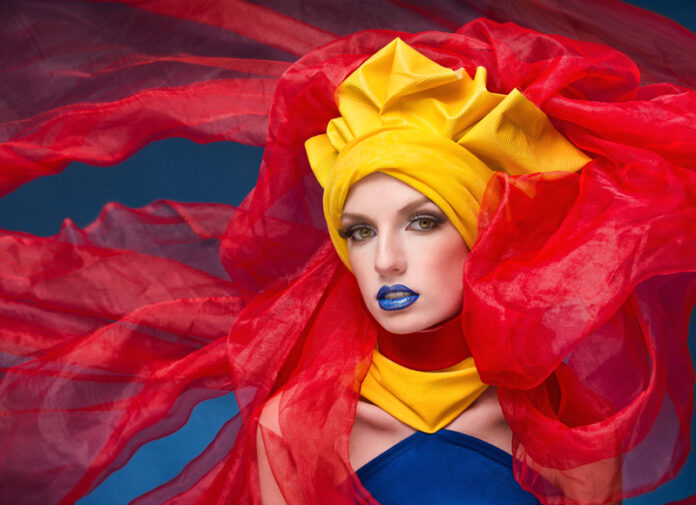By Joe Edelman
Texas School Instructor
Portraits usually serve a purpose. It might be a formal portrait printed, framed, and hung on a wall. A portrait could be a headshot for modeling or acting. Corporate or business portraits appear on a company website, Linkedin profiles, or even in print in a brochure or annual report. The portrait could be used on a social media profile or even for a dating app. All of these portraits have specific guidelines (rules) you must follow if the portrait is to be successful.
Fashion photographers are allowed more freedom and can break many traditional composition, lighting, and exposure rules. Editorial fashion photographs tend to be more about a mood or concept, or idea than they are about a person or even a specific piece of clothing. These creative or fashion portraits allow us to take a little from both worlds and be as creative as we want to be and can be. I have always enjoyed the challenges of being a portrait photographer, but I built a business on being different and doing things differently than others. This is an excellent way to make your work stand out and be noticed.
Where to begin? – My sincere advice is to forget every rule you have ever learned about photography, except for the physics stuff (Inverse Square Law, Depth of Field, etc.), then find a collaborator or two. Definitely a makeup artist and maybe a stylist. If you are new to collaboration, my advice is to embrace it. The more creative input that goes into any image, the better it’s potential to be a WOW photograph. Do you think Annie Liebovitz or Lindsay Adler work alone?
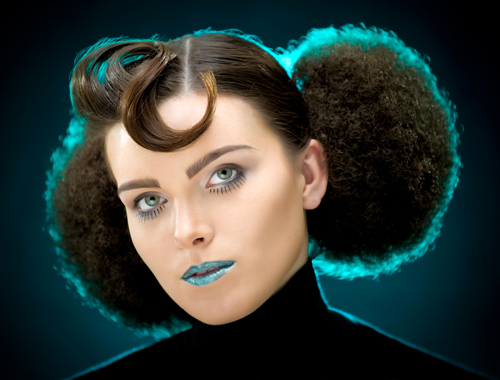
You can’t make a creative portrait without an interesting or unique face. I like big eyes, full lips, and a distinctive jawline and cheeks. I sincerely believe there is no such thing as a bad portrait subject; however, a unique face, male or female, definitely helps get you closer to that WOW response when people view your finished photograph.
Steal an idea or three. Yes, the best ideas are stolen, but let’s clarify what that means. When you see a concept and replicate it as closely as possible – that is practice. You are learning a technique, but please don’t be the photographer who shares “Xerox copies” of somebody else’s idea. I have thousands of photos on my phone that I have taken or saved because I liked a color combination, a portion of a pose, or part of a hairstyle or makeup design. I never try to replicate them; I steal pieces of numerous photos and add them to my own ideas to create something very different.
The Gear – You really don’t need special gear to shoot creative or fashion portraits. You are probably good to go if you can already shoot a portrait. A short to a medium-length telephoto lens is best. My go-to lens is my Tamron 70-180mm F2.8. I routinely work between 135mm – 150mm. For lighting, you can make these images with speedlights, studio strobes, and even LEDs. I find it easier when adding color and working with gels to stick with strobes or speedlights, but if you don’t mind raising your ISO and you are working indoors, RGB LED lights are a great option.
Modifiers don’t need to be big or fancy. I love the 32” and 43” white diffusion umbrellas I can shoot light through as well as my 33” folding beauty dish with the silver interior that I rarely use as an actual beauty dish. I prefer the look of the 33” double diffused softbox. By the way, I use round modifiers so that my subjects have round catchlights in their eyes, just like the sun creates.
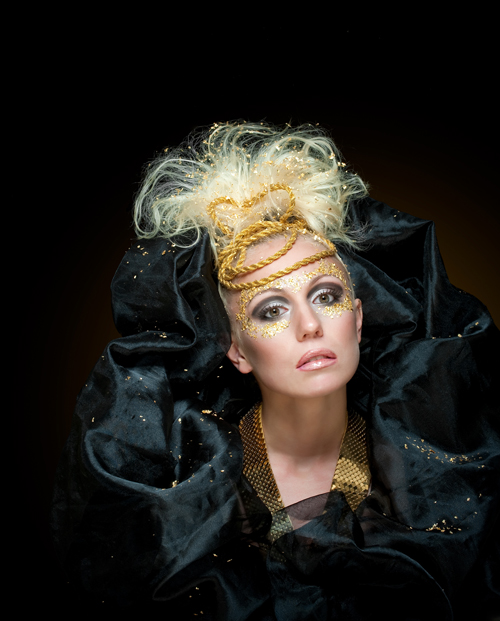 When it comes to backgrounds, my favorite background color is medium gray because I can use colored gels and make it any color I wish, including black or white. I can add sparkle to the color by layering sheer material with reflective designs. I often use a 65” LED TV mounted on a portable stand that allows me to have an infinite number of backgrounds, colors, and textures available.
When it comes to backgrounds, my favorite background color is medium gray because I can use colored gels and make it any color I wish, including black or white. I can add sparkle to the color by layering sheer material with reflective designs. I often use a 65” LED TV mounted on a portable stand that allows me to have an infinite number of backgrounds, colors, and textures available.
The Styling – Styling is where the image really begins to take shape. Simply put, it is a matter of what your subject is wearing or what you are wrapping or draping on your model. While it is great to collaborate with a stylist, feel free to dive in and see what you can come up with yourself. I hope you have taken my advice about collaborating with a makeup artist. That means you will have another creative mind available, so take advantage of that. There have been plenty of times when their input made the shot.
I also love accessories. Sunglasses, fashion collars, and hats are exciting additions to these photos. Amazon.com is an excellent source for finding these items that were made inexpensively overseas. I can purchase them cheap enough that I usually let my subjects keep them after the shoot. A little touch adds even more value to the session because that item will continually remind them of the experience.
Styling doesn’t need to be expensive. I frequently use items found at a dollar store or craft store. I love to work with things you wouldn’t consider wearables, like cellophane or plastic paint drop cloths. I am also a regular customer of the clearance racks at my local fabric store. Two to three yards of interesting material is plenty to create an exciting shoulder wrap or headpiece.
Be bold and contact local consignment shops and ask if you can purchase an outfit or accessories and then return it in a week or two and have them refund most of the money – provided that it is in perfect condition and they can still sell it. I have an arrangement like this with two local shops. Regardless of the original ticket price, when I return the item, they keep just $5.00 as a rental fee, and I give them a digital photo or two of the outfit on my model so that they can use it for their social media. It’s a win-win, and they even tag me!
The Shoot – If you plan to do a creative makeup look, you will likely only be doing one image in a session because the makeup can take upwards of two hours to apply. This gives me more creative freedom because I am not rushing to get multiple shots done in one session. My lighting for a creative portrait can range from a simple one-light setup to as many as five or six lights with a lot of colored gels. More often than not, I am working with three to four lights.
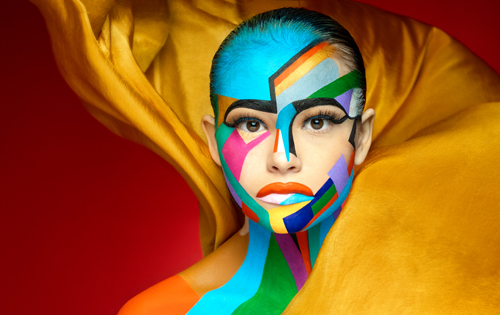
I will almost always set my key light first based on my subject’s best side and where I intend to have their nose aimed. I don’t do a lot of cross-lighting, and Rembrandt, well, he is dead, and it turns out he didn’t use his namesake lighting anyway! The rest of my lights are accents used as rims or background lights, usually with some form of a colored gel.
The real magic begins when the makeup is done, and I can bring my subject onto the set and begin shooting. You can see that I tend to shoot very close for these images, so attention to detail is critical. Fly-away hairs, crossed eyelashes, uneven eyeliner, and sloppy lipstick will ruin a shot or cause a lot of unnecessary time spent in post-production. I shoot tethered because it helps me slow down and spot those little details during the shoot.
My process for shooting these images is deliberate. I anticipate that my initial idea is ok, but I look at it as a portal to the finished shot, the arrangement and composition and pose and lighting that will grab me by the ears and not let me look away. The version that will make people pause and say, “WOW!” To accomplish this, “I work the shot.” I complete the shot the way I imagined it. Still, I make subtle changes in camera angle, lighting, pose, styling, and even hair or makeup, if necessary, until I find my way to that version that captivates my attention.
Post Production – I have a simple rule about processing my images. There are NO RULES! Creative fashion portraits allow me to process as much or as little as I like. These images are fantasies and do not need to be tied to reality in any way.
While I strongly encourage you to learn retouching and compositing techniques, don’t be intimidated by elder photographers who throw shade your way because you choose to outsource your retouching. Your clients only care about the finished result.
Clients? – Yes, you can make money shooting these creative portraits. I will remind you that in the late 1980s, women spent a lot of money on a Friday or Saturday evening at a GlamourShots® store. These volume photo studios could be found in shopping malls around the world. Think about it, why did women spend that money at a time when the economy was not great and then rarely display the photos in their homes? They paid for the experience… a night out with “the girls” and a chance to get dressed and have fun.
Today, Millenials and Gen Z’ers have spoken loud and clear that they will spend their disposable income on experiences over tangibles that take up space. Photographers provide day-long experiences that begin with a visit to a spa, then a hair salon, makeup, and finally, the photo shoot is pulling in session fees of several thousand dollars, and the networking potential with local businesses is excellent.
Have FUN! – The bottom line is to have FUN and explore the creative potential that we all have. Push your creative boundaries, and you will be surprised at what you can create. Take creative chances because even if you fail, you will learn, and as long as you are learning – “Your BEST shot – It’s your NEXT shot!”
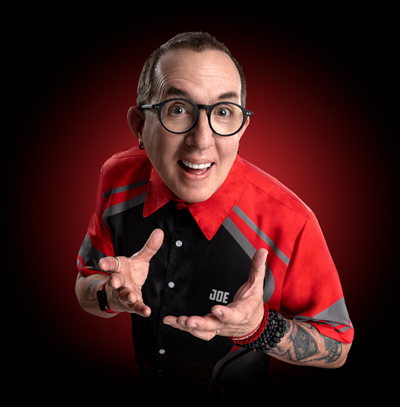 Joe Edelman Cr.Photog. is an award-winning photographer, author, and photo educator with over 50 years of experience photographing people. He is known for his practical no-rules approach to creativity and his ability to have fun shooting and talking about all things photography. He will be teaching a program, “Do Different, Be Different – Create Images That Stand Out,” at Texas School 2023.
Joe Edelman Cr.Photog. is an award-winning photographer, author, and photo educator with over 50 years of experience photographing people. He is known for his practical no-rules approach to creativity and his ability to have fun shooting and talking about all things photography. He will be teaching a program, “Do Different, Be Different – Create Images That Stand Out,” at Texas School 2023.



